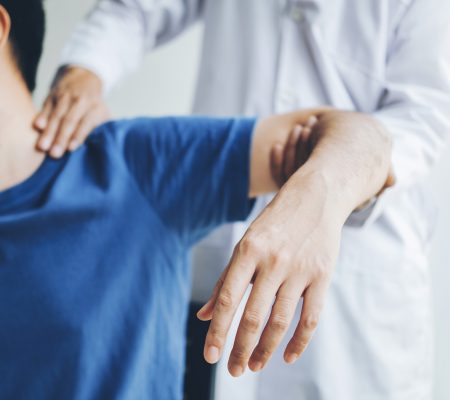Recovering from a Shoulder Injury: What You Really Need to Know
The shoulder is one of the most mobile joints in our body, but this excellent mobility comes with a price. With motion available in all directions, there is less stability in the shoulder joint, making it more prone to injury and reinjury. If you’re recovering from a shoulder injury, it may take time to heal.
Shoulder injuries can occur in any number of ways. You may experience an on-the-job injury if your work requires repetitive reaching forward or overhead—such as construction or painting. Athletes might injure a shoulder if they repeat overhead motion during sports like swimming, baseball, or volleyball. Injuries to the shoulder can also result from trauma, including a fall on the shoulder; injuries can even occur during seemingly simple tasks like yard work or lifting.
Regardless of how your shoulder injury occurs, you want to know what to do to make it better and quickly! At Orthopaedic Hospital of Wisconsin, our team of experts can help you get on the right path for recovering from a shoulder injury. Our practitioners are happy to guide you in your recovery.
Anatomy of the Shoulder Joint
If you want to understand why shoulders are susceptible to injury, you must first explore the shoulder joint’s anatomy and mechanics. Learning about the shoulder’s components can help you pinpoint where you’re experiencing pain. If you’re recovering from a shoulder injury, this knowledge will allow clear communication between you and your care provider.
The shoulder joint (or glenohumeral joint) is a ball and socket. The head of the humerus (ball) sits in the glenoid fossa (socket) of the scapula (shoulder blade). The other shoulder joint component is where the scapula and clavicle (collarbone) meet to make up the acromioclavicular or AC joint. The shoulder joint stability relies on the surrounding rotator cuff muscles (supraspinatus, infraspinatus, teres minor, and subscapularis), as well as the long head of the bicep muscle, labrum, and ligaments.
Orthopaedic Hospital of Wisconsin physical therapist Laura Sullivan says, “The shoulder is such a fun and challenging part of the body to treat because there are so many components that need to work together exactly right for the shoulder to function properly.”
Common Shoulder Injuries
As explained above, any of the components of the shoulder are susceptible to injury. Understanding the symptoms and signs of common issues can help you on your path to recovering from a shoulder injury. Here are some of the most common types of shoulder injuries.
Shoulder Impingement or Bursitis
Shoulder impingement and bursitis occur when space decreases between the tendons of the rotator cuff muscles, bursa, and acromion; this results in a “pinch” that causes shoulder pain. The pain may worsen when raising your arms overhead or reaching behind your back.
Shoulder impingement and bursitis are most common in people who perform repetitive overhead motions, such as athletes or construction workers. These shoulder issues can also occur when people make new, unusual repetitive motions such as raking, shoveling, or painting.
Rotator Cuff Tear
A rotator cuff tear can occur from trauma such as a fall onto the shoulder or wear and tear over time due to repetitive movements. A tear can be partial or complete. Patients with a rotator cuff injury often experience constant shoulder pain, especially at night, when lying on the shoulder. They may feel pain radiating from the shoulder down the arm to the elbow and have difficulty raising the arms overhead or reaching behind the back.
Labral Tear
A labral tear is also known as a SLAP tear. The labrum lines the glenoid fossa and keeps the head of the humerus stabilized in the joint. A labral tear can be an acute injury resulting from a fall with the arm outstretched, lifting something heavy, or a dislocation. It can also be chronic “wear and tear” damage to someone who makes a repetitive overhead motion. These injuries often present as pain across the top or along the front in the shoulder joint, feelings of “catching” or “popping” when moving the arm forward or overhead, weakness, and pain at night.
Adhesive Capsulitis
Adhesive Capsulitis is also known as “frozen shoulder.” This shoulder injury results from the thickening of the joint capsule and the forming of adhesions, causing the shoulder to be stiff, painful, and weak.
Over time, there is a gradual loss of motion in the shoulder with increasing pain. The symptoms are very similar to other shoulder injuries. However, recovering from Adhesive Capsulitis can take months and sometimes up to a couple of years if not treated early.
AC Joint Sprain
Injuries to the shoulder’s acromioclavicular joint often occur because of trauma such as a fall or a direct blow to the shoulder. AC joint sprain symptoms include swelling or bruising, limited arm movement, and a change in the shoulder’s shape where the shoulder appears to sag or the collarbone seems elevated.
Shoulder Fracture
A fracture can occur to any of the bony components of the shoulder joint: the humerus, clavicle, or scapula. These injuries happen most often from a fall or a blow to the shoulder and present with pain, swelling, bruising, inability to move the arm, and sometimes a deformity of the shoulder joint. Doctors often use X-rays to confirm the presence of a fracture.
Arthritis
Osteoarthritis, rheumatoid arthritis, and post-traumatic arthritis are also conditions of the shoulder joint. These occur when articular surfaces where the joints meet become damaged due to wear and tear, inflammation, or a prior shoulder injury. These conditions can also be very painful and may accompany other injuries to the shoulder.
Treating Pain and Recovering from a Shoulder Injury
So now that you’ve gotten an idea of what’s causing your shoulder pain, what should you do? How can you start recovering from a shoulder injury?
OHOW’s skilled physical therapists can help guide you through early interventions to address your shoulder concerns. These recommendations will often include resting the shoulder and modifying activities that increase pain. Your practitioner may recommend using ice and occasionally over the counter medication to manage pain. They will encourage and guide you through exercises to improve the shoulder’s range of motion and strength.
“As PT’s, we are trained to do a thorough assessment of the mechanism of injury, identify what aspects of the shoulder’s mobility and strength are affected, and determine an appropriate treatment progression to restore mobility and enhance strength and stability,” Laura explains. “It is so rewarding to help our patients eliminate their pain and return to their normal activities without any limitations from their shoulder injury.”
If, after attempting rest, ice, and physical therapy, your shoulder pain is not improving, it could be time to consult with one of OHOW’s orthopedic doctors. They will perform a thorough examination and help you determine the appropriate plan for your shoulder. This guidance may include medication, injection, imaging, or a discussion about surgery.
If you have questions or are dealing with a shoulder injury that is not improving, please request an appointment with one of OHOW’s orthopedic doctors or physical therapists.


